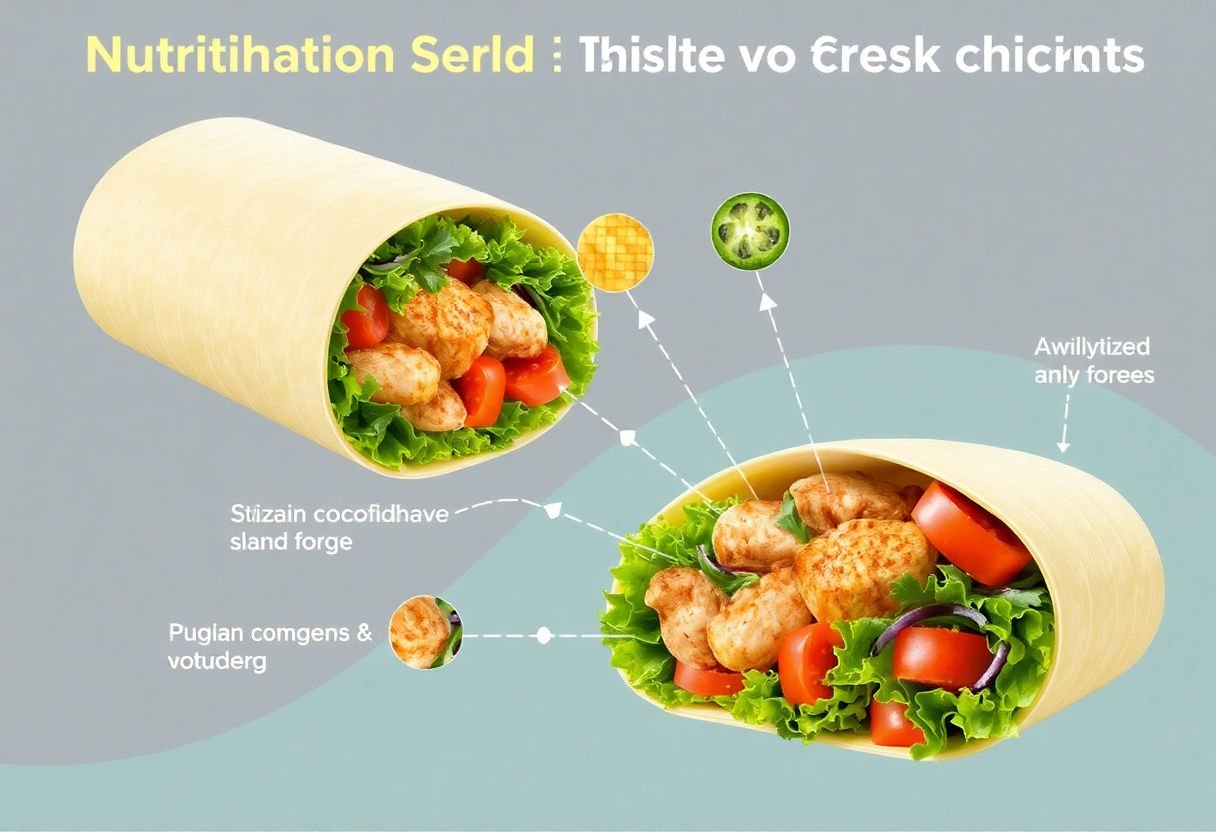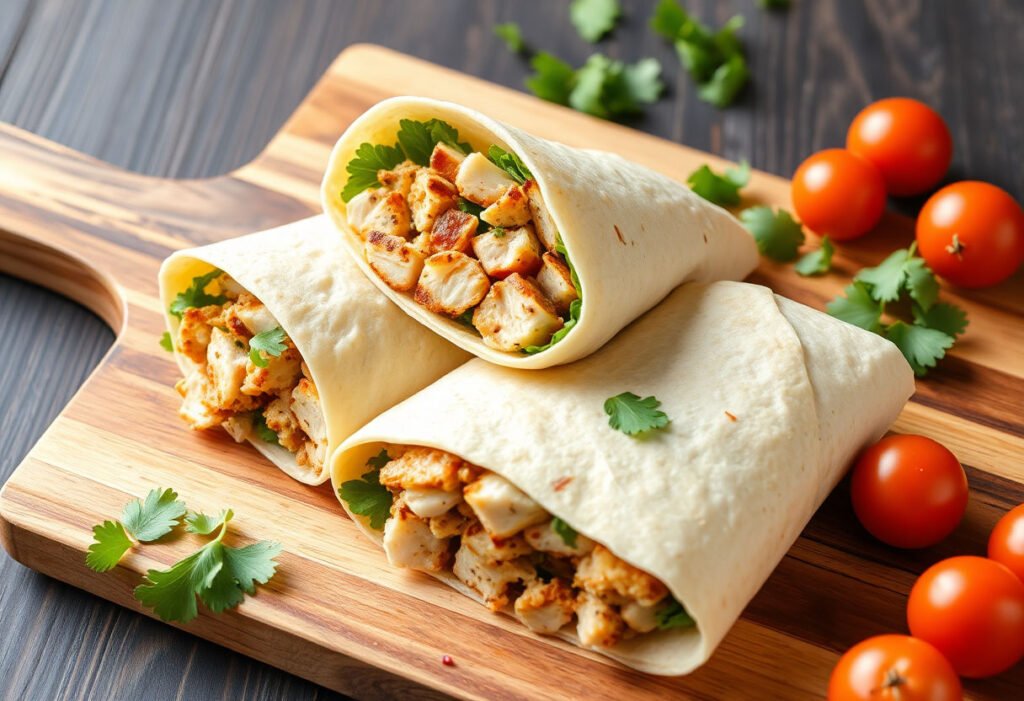Chicken wraps have rapidly gained popularity as a convenient and nutritious meal prep option, offering a delightful blend of flavors and textures. These wraps are not only delicious but also provide substantial nutritional benefits—making them an excellent choice for health-conscious individuals. Throughout this guide, we will explore the essential ingredients needed, numerous recipe ideas to spark creativity, and meticulous steps to ensure successful preparation. Prepare to master the art of chicken wraps while learning valuable tips for storing and reheating, all tailored to suit diverse dietary requirements. Dive in to revolutionize your meal prep routine with this ultimate guide.
Key Takeaways
- Chicken wraps offer a balanced meal option, providing an excellent source of protein and essential nutrients.
- With a variety of ingredient choices, chicken wraps can be easily customized to suit diverse dietary preferences and needs.
- Preparing chicken wraps in advance saves time and ensures you have a nutritious meal ready to go.
- Proper storage and reheating techniques preserve the taste and quality of your chicken wraps, extending their shelf life.
- Avoiding common preparation mistakes enhances the flavor and texture of your wraps, making them more enjoyable.
Understanding the Nutritional Benefits of Chicken Wraps

Chicken wraps are not only delicious but also offer numerous nutritional benefits that make them an ideal choice for meal prep. One of the primary advantages is their high protein content, as they predominantly feature chicken breast, a lean source of protein essential for muscle growth and repair. In addition to protein, chicken wraps often incorporate a variety of vegetables, providing an excellent source of vitamins and minerals.
Vegetables typically included, such as lettuce, tomatoes, and bell peppers, are rich in vitamin C and antioxidants, contributing to a well-balanced diet and supporting immune function. The use of whole grain wraps adds fiber, which aids in digestion and promotes a feeling of fullness, assisting in weight management.
Furthermore, chicken wraps can easily be customized to accommodate dietary preferences and restrictions. For those seeking lower carbohydrate options, using lettuce leaves as wraps can offer a delightful alternative while maintaining most of the nutritional benefits. The addition of healthy fats, such as avocado or hummus, provides essential fatty acids that support heart health.
Integrating herbs and spices, like oregano and cumin, not only enhances flavor but can also boost overall health, as many spices have anti-inflammatory properties. By choosing the right combination of ingredients, chicken wraps can serve as a versatile meal that aligns with various nutritional goals and dietary needs, making them a valuable option for health-conscious individuals.
Essential Ingredients for Chicken Wraps
When it comes to crafting the perfect chicken wrap, the choice of ingredients plays a pivotal role in both flavor and nutritional value. Here’s a look at some essential ingredients that can elevate your chicken wraps to a new gastronomic level:
-
Chicken: The star ingredient, chicken provides a hearty and lean protein source. Opt for skinless chicken breast or thighs for a balance between flavor and nutrition.
-
Wraps or Tortillas: Selecting the right base is crucial. Whole wheat, spinach, or gluten-free wraps are popular choices due to their nutritional benefits. Each type adds a different texture and taste to your meal.
-
Fresh Vegetables: Incorporate a colorful array of vegetables like lettuce, tomatoes, bell peppers, and cucumbers. These not only add a fresh crunch but also boost vitamin and fiber intake.
-
Cheese: A modest amount of cheese can enhance flavor and creaminess. Options like feta, cheddar, or mozzarella work well, depending on your taste preference.
-
Dressings and Sauces: To bring all components together, consider using sauces such as hummus, tzatziki, or a light vinaigrette. These can introduce a touch of tanginess or creaminess without overwhelming the wrap.
-
Herbs and Spices: Adding herbs like cilantro or basil along with spices such as cumin or chili powder can significantly enhance the aromatic profile of your chicken wraps.
To enhance customization, you might experiment with various ingredient combinations to suit different palates and dietary needs. Whether you are prioritizing health, taste, or convenience, these ingredients serve as the building blocks for delicious and nutritious chicken wraps.
Step-by-Step Guide to Prepping Chicken Wraps
To prepare chicken wraps that are both delicious and efficient for meal prep, follow these step-by-step instructions to ensure consistency and flavor.
1. Select and Prepare Your Ingredients
Start by gathering high-quality ingredients. Choose fresh chicken breast, opting for organic or free-range if possible. Gather additional components such as whole-grain wraps, vibrant greens like spinach or lettuce, chopped vegetables like bell peppers, and a flavorful spread like avocado or hummus.
2. Cook the Chicken
Begin by seasoning the chicken with a mix of herbs and spices such as garlic powder, paprika, salt, and pepper. Grill or sauté the chicken until it reaches an internal temperature of 165°F, ensuring it is cooked thoroughly. Let the chicken rest for a few minutes before slicing it into thin strips to maintain juiciness.
3. Assemble the Wrap
Lay out each wrap and spread a thin layer of your chosen spread across its surface. This not only adds flavor but also keeps the wrap from becoming soggy. Place a generous portion of greens followed by the sliced chicken strips. Add your chopped vegetables for crunch and variety.
4. Wrap It Up
To avoid wrap unraveling, fold the sides in before rolling tightly from one end to the other. Use parchment paper to secure each wrap, making it easier to store and transport.
5. Store Your Wraps
Place each wrapped chicken wrap into an airtight container or a resealable plastic bag. Store in the refrigerator for up to four days. This ensures they remain fresh and flavorful for your meal prep needs.
Proper preparation not only enhances taste but also preserves the nutritional benefits of these delicious chicken wraps.
Tips for Storing and Reheating Chicken Wraps

Storing and reheating chicken wraps correctly is essential to preserving their freshness and flavor. Here are some practical tips to keep in mind:
-
Storage Containers: Use air-tight containers or carefully wrap the chicken wraps in aluminum foil or plastic wrap to prevent air exposure, which can lead to spoilage. If possible, utilize glass containers, as they tend to hold flavor better than plastic.
-
Refrigeration: Always store wraps in the refrigerator if you plan to consume them within three days. This maintains their quality and inhibits bacterial growth.
-
Freezing: For longer storage, wraps can be frozen. Ensure they are well-sealed to prevent freezer burn. Wrapping each wrap individually allows for convenient single servings.
-
Reheating Instructions: When reheating, it’s important to avoid the microwave’s tendency to make wraps soggy. Instead, consider using a skillet or an oven. Preheat the oven to 350°F (175°C), wrap the chicken wrap in aluminum foil, and heat for about 10-15 minutes. This method maintains texture and taste.
-
Safety Precautions: Always check the internal temperature of the reheated chicken wrap to ensure it reaches at least 165°F (74°C), ensuring it is safe for consumption.
By adhering to these guidelines, you can enjoy the same delicious taste and texture as the freshly made version of your chicken wraps. Taking the time to properly store and reheat them will provide you with a nutritious and satisfying meal whenever you need it.
Common Mistakes to Avoid in Chicken Wrap Preparation
When preparing chicken wraps, it’s easy to fall into some common pitfalls that can compromise their taste and texture. Here are several critical mistakes to avoid:
-
Overcooking the Chicken: Overdoing the cooking time can result in dry and tough chicken, which will detract from the juicy texture that’s synonymous with a perfect wrap. Aim for an internal temperature of 165°F and allow the chicken to rest before slicing.
-
Using Inappropriate Wraps: Choosing a wrap that is not sturdy enough can result in a mess. Opt for thicker or whole-grain options, which provide better structural integrity and additional nutritional benefits.
-
Neglecting Flavor Balance: An imbalanced wrap can be overly spiced, or bland. Ensure there’s a harmony of flavors by incorporating a variety of seasonings and sauces, balancing spiciness, acidity, and sweetness.
-
Inadequate Fillings Proportion: It’s essential to avoid overfilling, which can lead to a wrap that’s challenging to eat and may fall apart. Strive for a balanced distribution of chicken, vegetables, and sauces to maintain stability and flavor.
-
Ignoring Freshness: Some ingredients may wilt or become soggy if prepared too far in advance. Fresh herbs, lettuce, and other vegetables should be added just before serving or consuming to preserve their crispness and vibrancy.
By paying attention to these details, you can ensure that each chicken wrap is not only delicious but also maintains the optimal texture and flavor, making your meal prep efforts worthwhile.
How to Customize Chicken Wraps for Dietary Needs
Customizing chicken wraps to accommodate various dietary needs is both simple and rewarding, ensuring everyone can enjoy this versatile meal. Here’s how to tailor your chicken wraps:
Gluten-Free Options
For those with gluten sensitivities or celiac disease, gluten-free tortillas are a must. Look for options made from rice, corn, or almond flour. It’s important to verify that all ingredients, including sauces and spices, are gluten-free.
Low-Carb Adjustments
To reduce carbohydrate intake, consider using lettuce leaves or collard greens as a wrap alternative. These options provide a crisp and refreshing texture, perfect for a low-carb lifestyle. Additionally, focus on high-protein fillers such as grilled chicken and avocados, while excluding starchy vegetables.
Vegan or Vegetarian Adaptations
Vegetarians and vegans can replace chicken with grilled tofu or tempeh. Adding an assortment of colorful vegetables like bell peppers, spinach, and shredded carrots can enhance both flavor and nutritional value. Use hummus or vegan-friendly sauces for added moisture and taste.
Dairy-Free Choices
For those avoiding dairy, opt for dairy-free cheese or omit it entirely. Instead, use ingredients like guacamole or pesto to add creaminess. Many traditional wraps contain sauces or dressings with dairy, so check labels carefully and choose alternatives if necessary.
Nut-Free Considerations
When preparing for individuals with nut allergies, ensure all ingredients, including wraps and sauces, are nut-free. Substitutes such as sunflower seed butter make excellent alternatives in recipes traditionally using peanut or almond elements.
These customizations ensure that chicken wraps remain a delicious and inclusive option, catering to a range of dietary preferences and restrictions.
Conclusion
Incorporating chicken wraps into your meal prep routine offers a wealth of nutritional benefits while providing variety and convenience. Through understanding key ingredients and mastering preparation techniques, you can enjoy delicious and sustaining meals tailored to your dietary needs. Avoiding common pitfalls and storing your wraps effectively ensures each meal will be as satisfying as the last. As you experiment with creative recipes, embrace the flexibility to adjust flavors and ingredients to your preferences. By doing so, you enhance not just your meals but your overall lifestyle, indulging in healthier, more flavorful eating habits.
Frequently Asked Questions
How can I ensure my chicken wraps remain fresh throughout the week?
To ensure freshness, store your chicken wraps in an airtight container in the refrigerator. It’s important to keep ingredients separate until you’re ready to eat, preventing the wraps from becoming soggy.
What are some common ingredients that I can substitute for dietary needs?
There are numerous substitutions available for dietary needs. For gluten-free wraps, consider using corn tortillas or lettuce leaves. Vegetarian options can include chickpeas or tofu as protein sources instead of chicken.
How long can I store chicken wraps in the fridge?
Chicken wraps can typically be stored in the refrigerator for up to four days. Ensure that your chicken is cooked thoroughly and that all ingredients are properly cooled before wrapping and storing.
Can I freeze my chicken wraps for future meals?
Yes, chicken wraps can be frozen for longer storage. Wrap them individually in plastic wrap or foil, and place them in a freezer-safe bag. To reheat, thaw them in the fridge overnight and warm them in a microwave or oven.
How can I add variety to my chicken wraps without compromising health?
Incorporate a range of fresh vegetables, herbs, and spices to add flavor while keeping the wraps nutritious. Try using different sauces or dressings such as hummus or yogurt-based dressings for a healthy twist.


